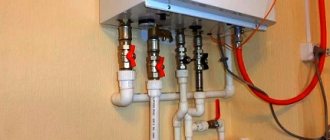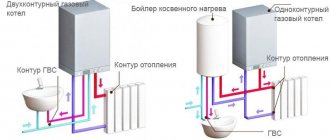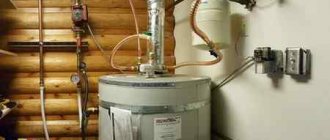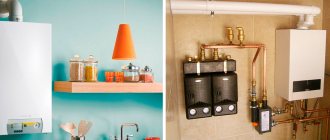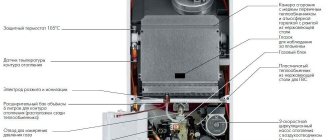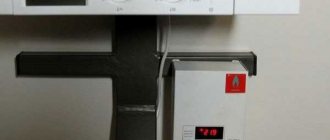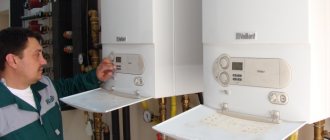For heating networks in private houses and apartments, it is advisable to use boilers with closed coolant circulation, i.e. double-circuit. This design allows you to increase the pressure of the working fluid in the circuit.
High pressure in the heating system ensures safety and a higher boiling point of the coolant, therefore, the economic effect of the installation increases, and a decrease in pressure leads to problems in the system. Therefore, let’s look at why the pressure in the heating system of a double-circuit boiler drops and how to raise it.
The parameters of the boiler unit are monitored by measuring instruments - pressure gauges, main and additional. If a pressure gauge should be included in instrumentation and control measures, then choose models with electronic sensors.
Factors that affect the pressure inside the circuit:
- The impact of the coolant on the walls of the heating network elements;
- Height of laying pipes, hanging radiators and boiler unit;
- Design of main pipeline sections.
The pressure value for autonomous heating is not standardized. Acceptable values of network parameters are calculated based on the data of a specific object:
- Boiler type, pipe characteristics (diameter, presence of reinforcement, etc.), type and number of radiators;
- Equipment installation location, circuit length;
- Number of floors of the house;
- Parameters and condition of the external water pipeline.
Reasons for pressure drop in the circuit:
- Presence of leaks in the pipeline;
- Malfunction of the boiler, cracks on the surface of the heat exchanger;
- Malfunction of the membrane valve responsible for the safety of boiler equipment;
- Failure of the expansion tank membrane;
- Depressurization of the hot water supply circuit.
Why does pressure increase in a double-circuit gas boiler?
Let's consider the reasons why the pressure in a double-circuit boiler can constantly increase (or rather, increase until the pressure relief valve in the boiler operates). Considering that the operating principle of most boilers is similar, this malfunction can manifest itself in various models: Baxi, Ariston, Buderus, etc.
When the pressure in a double-circuit gas boiler drops, this is somehow understandable, but when the pressure itself increases! However, this is exactly what I once had to face - having bought a renovated apartment, signed a sales contract and received the keys, I did not spend the night in it and in the morning I discovered puddles of water on the floor and a damaged cabinet for a gas boiler.
Causes of drop in pressure
The reasons for the pressure drop in a gas boiler are as follows:
- Water is leaking from the heating system.
- The electricity was cut off for a long period.
- Malfunctions of the main expansion tank.
- Incorrect boiler selection.
Due to low pressure the boiler stops working. When the water pressure in the heating network reaches a minimum level, water does not flow into the main heating system. When the gas pressure in the boiler drops, it immediately turns off automatically. To avoid such difficulties, you need to regularly carry out maintenance of such devices. To do this, you need to invite specialists from the service department.
The pressure in the heating system in a wall-mounted boiler increases
The presence of a stable operating pressure in the heating system (1 - 2 bar) is the key to the safe operation of a double-circuit gas boiler. The boiler will not start if the system pressure is less than 0.6 bar; if more than 3 bar, an emergency water discharge occurs.
- There are two reasons why the pressure in a double-circuit gas boiler can gradually but constantly increase:
- does not hold the make-up valve (most likely);
- The secondary heat exchanger is faulty.
This usually happens like this: the pressure slowly increases (sometimes you may not notice this and leave for a few days) until the safety valve is activated (usually at 3 bar). And so several times, in a cycle. As a result, the floor in the kitchen is flooded, the furniture and mood are ruined.
The heating system is autonomous (not connected to the water supply). This is essentially a closed circuit that can be heated by a gas burner. But to fill this heating circuit with water, there is a make-up tap, and if it leaks, then water from the water supply will leak into the heating system (increasing the pressure there).
Well, the second (unlikely) option is that in the secondary heat exchanger the water supply and heating pipes are located side by side, literally through a thin wall. And if a fistula has formed there, then there may be leakage from the water supply system into the heating system (until the pressure is equalized). And if the pressure in the cold water supply is more than 3 bar, the same pressure will eventually be in the heating system. Which will trigger the emergency valve (and release some of the water).
How to fill the heating system of a double-circuit boiler
The heating system of a double-circuit gas boiler is filled through a make-up tap, which is included in the basic configuration of any boiler:
Expansion tank and its bleeding
In a closed-type system, the cause of a drop in pressure in the circuit may be the failure of the expansion tank.
- Frequent recharge of the system. If there is a need to additionally introduce coolant into the system at least once a week, without visible leaks, then the problem lies in the incorrect operation of the expansion tank;
- Dispersion of pressure gauge readings for different operating modes of the system. A sharp drop in coolant pressure in the system when using hot water supply also indicates a malfunction in the RB.
Pressure inside the expansion tank
To check its functionality, it is necessary to pump the tank and check that the pressure in it corresponds to the pressure in the heating system.
Sequence of pumping actions:
- Close the shut-off valves (direct and return water supply);
- Open the fitting, drain the water until the pressure in the boiler becomes zero;
- Take readings on the expansion tank in the “open” position. The presence of condensation on the RB should not be observed;
- Pump air into the RB until liquid stops flowing from the fitting. Allow the water to drain completely from the tank;
- Release the air;
- Repeat the procedure, keeping the pressure in the RB at 1.1...1.3 bar;
- Open the shut-off valve;
- Connect the coolant to the network. Set the pressure level to 1…1.1 bar.
Air injection
If there is no special pump for RB, you can use a regular bicycle pump.
The pressure in the double-circuit boiler drops
This is a fairly common problem - it manifests itself in the fact that the pressure in the heating system slowly decreases and when it drops below normal, some boiler models turn off.
Most often, the cause is a simple water leak from pipes or leaky radiators. It is not easy to detect such a leak during the heating season - you will not see a puddle on the floor (well, of course, unless it is a serious leak). Most often, these will be just droplets and you will not see these droplets, since they quickly evaporate from heated pipes.
How and where to look for a leak - you need to pay attention to radiator plugs, joints or soldering of pipes and fittings. You can often see traces of water leaks in the form of rusty or salt stains. It will be easier to detect various types of leaks if you turn off the heating for a while, let the radiators cool and add pressure to about 2.5 Bar. After this, you will be able to see drops or puddles on the floor.
The boiler can also be the cause of the leak. For example, the primary heat exchanger itself or its connections are leaking. But as long as these are small droplets, you will not notice anything; they evaporate during operation of the boiler. As soon as it starts to leak more actively, you will notice “drops” from the boiler.
Pressure drops in a double-circuit boiler when hot water is turned on
When you open a hot water tap, the pressure in the heating system drops (by about 0.3 atmospheres). The tap is closed and the pressure is restored.
Why did the water pressure drop?
What affects the indicators in the circuit:
- The installation height of the housing, as a result - the height and length of the pipes.
- The effect of liquid on pipes and other elements.
- Construction of main tracks.
If your home has autonomous heating, then the standards depend on:
- Boiler models, pipeline paths.
- Installation locations.
- Number of floors in the building.
- Characteristics of the outer pipe.
Next we'll look at non-installation related reasons. If the device releases and does not gain pressure, this may be an internal failure or external factors.
Leak in the system
You add coolant to the circuit, but the pressure is still low. If the batteries heat up well, the moisture evaporates quickly, making the leak difficult to detect. Take a dry cloth and go over all pipe joints and connections. Look, there may be puddles accumulating under the radiators.
If the leak cannot be detected, use a compressor.
- Disconnect the radiators from the heating device.
- Drain off all liquid.
- Connect a compressor to the taps.
- Bleed the circuit with air.
- You will hear extraneous sounds in places where there is damage.
- To seal, use plumber's tow or sealant.
Are your radiators built into the wall? Then contact the specialists. They will conduct a thermal imaging check. All you have to do is open up the damaged area and carry out repairs.
Incorrectly selected boiler - the power does not correspond to the established parameters of the pipeline. Therefore, the pressure constantly drops and does not hold.
If the values drop quickly, the cause may be the expansion tank . At the same time, you fill in the coolant every week, but it is becoming less and less, although no leaks have been detected. There is also a pressure drop in the mixers.
How to gain and improve performance:
- Turn off the water supply valves.
- Drain the circuit completely.
- Open the fitting on the expansion tank (RB) and record the numbers.
- Pump air until all the water comes out.
- Bleed the air and repeat the steps. Make sure that the needle on the pressure gauge does not exceed 1.3 bar.
- Open the taps and fill in the liquid.
If after the procedure the pressure drops and does not rise, inspect the membrane for damage. Replace if necessary.
Heat exchanger malfunction . After checking the pipes and connections, were there any violations found? Inspect the radiator for damage. A large accumulation of scale on the tubes leads to frequent flushing with reagents. This causes the material to quickly wear out and cracks to appear.
The bithermic unit cannot be repaired due to its design. Will need replacement. If a tubular radiator is installed, remove it. Fistulas can be detected by green spots on the surface. Dry the device and clean the damaged area with sandpaper. Then carry out soldering with a soldering iron or torch.
Unfortunately, after repair the unit will not last long. Therefore, sooner or later you will have to change it.
Problems with the water supply valve . When a faucet leaks, it leads to a constant drop in pressure. How to add coolant to the system? Only replacing the part will help.
Why does the pressure in the boiler keep rising and falling?
An expansion tank is a sealed container divided in half by a membrane, one half of the tank is filled with inert gas (or just air), the other is filled with coolant (water). It is designed to compensate for the pressure created during the expansion of the heated coolant. Water expands when heated, and if it has nowhere to expand, it will burst heating radiators or pipes (since liquids are practically incompressible).
The expansion tank must be filled with air at a pressure of approximately 1.5 bar (see the instructions for the specific boiler for the exact figure). Air is pumped there through a spool (like in a car or bicycle), and if it leaks, the pressure will drop over time. To check, moisten the spool nipple head with a drop of water; if bubbles appear, the unit is faulty and requires replacement.
To check the tightness of the expansion tank membrane, open the feed tap. If the pressure rises at the moment, this is the first sign of lack of compensation. The membrane allows water to pass through, the air cavity behind the membrane is filled with water and does not compensate for the pressure. To check, you can press on the nipple of the spool valve, through which air is pumped into the expansion tank - water will flow out of it.
The pressure in a closed heating system can also change due to a large amount of air not removed from the system. And although modern boilers are equipped with automatic air vents, they may not work over time due to scale build-up.
Source
Types of pressure
Why does the pressure drop in a wall-mounted unit? First, let’s figure out what types there are and how they affect the operation of the equipment.
- Static. The higher the height, the higher the performance. With every meter there is an increase of 0.1 bar.
- Dynamic. Forced operation of the pump creates the rated pressure in a closed system.
- Working. Includes the two options above.
- Excessive. Determined by a pressure gauge as the difference between atmospheric and fixed.
- Nominal. The one indicated by the manufacturer in the documentation for a specific model.
- Maximum. The maximum that is allowed to avoid breakdowns and accidents.
- Crimping. Used in production when testing equipment.
In the heating circuit, indicators are measured in atmospheres. They may vary; It is important that the value does not exceed the permissible maximum and minimum thresholds. A low value is only possible when coolant is pumped into the circuit. In other cases, it should not deviate from the norm.
Boiler recharge: automatic and manual
During operation of the heating boiler, the volume of internal coolant that circulates from the source to the heating devices and back decreases, reducing the pressure in the network and the quality of heat transfer.
If such a circuit is not replenished with network water, then the pressure level will gradually drop to 0 atm, which will cause an emergency stop of the boiler unit. Therefore, according to the requirements of the rules for the safe operation of gas and solid fuel units, boilers must be recharged.
For this purpose, a special unit is used, the responsibility for the presence of which rests with the manufacturers of the units. Therefore, for all certified devices, for example, an Ariston boiler feed tap is included in the basic delivery kit.
Reasons for increased pressure in case of boiler damage
It is difficult for a person who does not have experience in servicing heating systems to independently determine the true reason why the pressure in the heating boiler rises. However, to give you an idea of possible malfunctions, a list of probable causes is provided.
- Increasing pressure up to 1 atm. may occur as a result of depressurization of the heat exchanger. Such consequences result from the formation of cracks in the housing during prolonged operation. The appearance of cracks may be the result of a manufacturing defect or poor strength of the material, the consequences of a water hammer or equipment wear. In this case, the coolant volume systematically begins to replenish. However, it is not possible to visually determine the location of the leak due to the instantaneous evaporation of the liquid when the burner is running. This malfunction leads to replacement of the heat exchanger.
- An increase in pressure can occur when the make-up valve is open. The weak pressure inside the boiler contrasts with the increased pressure in the pipeline. This causes additional water to flow through the open valve. Thus, the water pressure will gradually increase until it is released. If the pressure in the pipeline decreases, the water supply to the boiler is shut off by the coolant, reducing the pressure in the circuit. The make-up valve must be kept closed, and if it is broken, replaced.
- An increase in pressure may occur due to a malfunction of the three-way valve. Such a breakdown leads to water entering the circuit from the expansion tank. Debris periodically collects on the valve, which can cause it to break. This element must be cleaned periodically and, if faulty, replaced. To prevent contaminants from entering the water supply, you can install a simple corner filter.
- If all signs indicate that the pressure in the circuit is increasing, and the pressure gauge needle does not respond, this means that it has failed. A broken device makes it impossible to control the operation of the system and needs to be replaced.
Excessive pressure in the heating circuit is determined by the readings of the pressure gauge; if the indicator exceeds the permissible level, measures must be taken immediately. In addition to the pressure gauge, an excess of the permissible norm can be indicated by a safety valve, from which water will begin to flow if the pressure has risen.
Signs that there is not enough water in the heating system
Operating personnel or the owner of the boiler unit must accurately determine the deficiency of coolant in its circuit. First of all, using a pressure gauge, since the pressure of the medium in the network will drop if there is a leak.
In modern autonomous systems equipped with multifunctional automation, water leakage from the heating network is included in the mandatory indicator for boiler protection, therefore, if it falls, the personnel will be warned by alarms: audio and visual.
For older modifications of the boiler, a drop in coolant pressure due to unproductive leaks is determined by the following criteria:
- overheating of the supply coolant, despite the fact that the radiators quickly cool down due to disruption of water circulation in them;
- the water in the network begins to gurgle, especially in heating risers;
- the boiler clocking process begins, when the burner of the gas unit is often turned on/off;
- activation of the safety valve of a solid fuel boiler due to overheating of the coolant.
The situation with leaks is especially dangerous in solid fuel boilers, since due to the high inertia of the combustion process, the boiler cannot stop until all the stored fuel has burned out, which means there is a high possibility of overheating of pipes or heat exchangers located in the firebox, with their subsequent rupture and leakage open fire source in the furnace room.
basic information
A modern house is a complex communications system; automation of units makes it possible to reduce interference in their operation to a minimum. Despite this, owners of heating systems face a number of problems. Experts identify five main reasons for pressure drop in a closed heating system:
- radiator failure;
- installation errors;
- discrepancy between the boiler power and the “native” pipeline;
- depressurization and leakage;
- interruptions/jumps in gas supply.
Types of pressure
To perform the work, it is recommended to study the instructions for the heating device and the principle of operation of the system. Based on the theoretical knowledge you have acquired, it will be easy for you to understand the reasons for the pressure drop in a wall-mounted or floor-standing boiler.
Let's understand the types of pressure and their effect on the operation of the heating system:
- static - with increasing pressure and the indicators increase by 0.1 bar;
- dynamic - forced pumping creates a nominal pressure in a closed heating system;
- working - operates within the technical instructions and controls the two above pressures;
- excess - determined using a pressure gauge based on the difference between the atmospheric and recorded indicators;
- nominal - indicated by the manufacturer in the technical documentation for a specific boiler model;
- maximum - permissible pressure at which the unit can operate without breakdowns and emergency situations.
Manufacturers indicate in the instructions that indicators in the heating circuit may vary, so it is important to take into account the permissible maximum and minimum limits for the operation of the selected model. A low value is only possible when pumping coolant into the circuit; in other cases, the pressure must be within the limits specified in the instructions.
Exercising control
According to modern standards, models of heating devices are equipped with control sensors. Their task is to monitor the pressure level and, in case of surges, temporarily or completely block the operation of the unit and system. By displaying the error code on the boiler information display, the user can read the information in the instructions or find the answer on the manufacturer’s official website.
The most well-known models of gas boilers support operation within 1.5–2 atm. Units of the Bosch, Ariston, Baxi brands, and a Navien boiler - all of them are produced with a forced fluid movement system and a pump, the pressure drop is controlled by a program.
Principle of operation
How does pressure work in gas boilers? Let us consider in detail the process of operation of the equipment.
- Turning on the unit starts the operation of the sensors, and from the first seconds the coolant temperature begins to be recorded.
- The outdoor thermostat, if provided with the model, is automatically activated, and you see how the arrow lights up and heating occurs.
- As the temperature increases, the pressure increases, the water heats up and expands. A safety valve is periodically turned on, which discharges excess into the sewer.
- Operation may malfunction if too much water goes down the drain - this leads to a drop in pressure.
- The boiler automatically turns off when the temperature set by the program is reached.
What happens inside the expansion tank? It consists of two parts separated by a diaphragm. Excess liquid accumulates in one part, and nitrogen in the second. The coolant fills the tank as much as the difference between the nitrogen values and the system value is large. Having reached the temperature set by the program, nitrogen pushes water out of the tank by deforming the membrane - heating stops.
How does the make-up valve work?
The valve is installed in order to maintain operating pressure in the internal circuit of the heating network by adding water from the city water supply. The standard pressure for the heating network depends on the number of floors of the building and internal pressure losses in the network; usually, a pressure of 2 to 2.5 atm is sufficient.
A pressure reducing valve is used as an automatic filing device. At the same time, if the water pressure drops, the pressure on the valve stops, the spring acts on the rod, moving it lower, and thus opens the hole in the seat. Through it, water from the city water supply or tank enters the network. As the system fills, the pressure will increase and close the membrane and hole.
The pressure reduction valve is especially often triggered in systems with an automatic air vent, which removes air from the network. In order to protect the system from the reverse movement of the medium through the reducer, a check valve is installed into the municipal water supply.
Which faucet to choose
The gas boiler feed tap is installed on almost all modifications of both domestic and foreign boilers: boiler feed tap Ariston, Baxi, Immergas, Ferroli and Vaillant. Usually the user is forced to replace such a faucet if the factory model malfunctions. In this case, it is best to install one similar to the one that was supplied with the boiler. When choosing another model, you need to pay attention to the dimensions, operating pressure and water flow.
Popular gas boiler feed taps:
- Ariston electromagnetic boiler feed tap, price: 1,780 rubles;
- Baxi Main boiler feed tap, price: RUB 1,590;
- boiler feed tap Bosch ZW23-1KE/AE, price: 1090 rub.;
- boiler feed tap Daewoo Gasboiler 100-300 ICH, price: 1820 rub.;
- make-up tap for boiler Vaillant Max, Pro, Plus, price: 590 rub.;
- make-up tap Immergas Mini 1.015093, price: 320 rub.;
- feed tap for Ferroli Divatech, Divatop double-circuit gas boiler, price: 800 rub.;
- make-up tap Protherm Panther v18, price: 560 rub.
Answers from Ariston Clas boiler repair specialists
Question: We installed a wall-mounted gas boiler Ariston clas evo 24 ff. Made a small change to the heating system. Before calling technical service for the first start, I wanted to fill the heating system with water and check it for density. but ran into a problem with filling the system with water. How to do it? Where is the fill valve located? Should the boiler be connected to the electrical network? And why do you need a make-up solenoid valve?
Answer: The solenoid valve for recharging is precisely what is needed for recharging. Only for this you need to turn on the boiler to the network, but I would not recommend doing this before the service arrives. Believe me, there are different situations during startup. And then, this valve does not power the system, but recharges it. To fill the system, they either make a connection from cold water to the return line (with a tap), which I personally do not favor, or they fill it manually through a valve.
Look at the valve from below and you will see a screw for a screwdriver. So, if you turn it (points to the letter A), then water will begin to flow into the system through the boiler (letter C - closed). A magnetic key is attached under the boiler next to the automatic make-up. You put it on the pin sticking out from under the boiler and feed it with CO.
Question: An Ariston class 24 ff gas boiler is connected, the heating season has ended, the heating has been turned off and now when the hot water is turned on, the boiler operates at the set temperature for about 10-30 seconds, after which it goes out and the message H46 appears on the screen (46 water temperature, looked H- there is a delay in turning off the pump in DHW mode, why didn’t I hear the pump working with UDC? I can hear it during heating), the water from the tap begins to get colder, then the boiler lights up and so on in a circle, it lights up, goes out, lights up.
When the boiler turns off, a gurgling sound is heard inside, as if water is boiling, periodically dripping from the chimney, apparently condensation from steam from the boiler, if at this moment you turn on the heating, the gurgling immediately stops, when operating in DHW mode, the heating pipe does not get warm when the boiler turns off, then if you turn on the heating, it shows the temperature in the heating circuit at about 80 degrees and drops quickly.
Help, otherwise I have no one else to turn to, we don’t have normal service in our city, and at home I think they’ll soon put this boiler on my head. And another question: the automatic air removal valve in the boiler near the pump must be closed after filling the heating system or it remains in the raised position, otherwise I think that steam goes into the chimney through it.
Answer: Carefully unscrew the large nut at the end of the pump and check whether the pump spins or not. Just take care of the board so as not to fill it with water. Cover with something. This valve must always be raised. I would start by cleaning the hot water flow sensor. It looks like the turbine in the DHW flow sensor is not rotating. If this does not help, then the secondary heat exchanger is clogged. If the heat exchanger is clogged, it needs to be cleaned. Remove the heat exchanger and check the condition of the CO channels. And before that, indirectly determine the operation of the boiler in DHW mode.
Open the boiler, turn it on in DHW mode and determine the flow and return temperatures of the primary heat exchanger. There is no need to dismantle the boiler. Secondary heat exchanger - installed at the bottom, stainless steel plate. Contamination may be from the primary circuit.
This happens especially often when using a boiler with a steel heating system that was not properly flushed or when using aluminum radiators. It is advisable to always use a filter on the return line of the heating system. Remove the heat exchanger and wash with appropriate products.
Question: An Ariston clas 24 cf wall-mounted boiler is installed. It worked great all winter, it’s been a week since it was turned off. Yesterday I wanted to turn it on because the weather had gotten colder, but it surprised me by giving me error 302. I press Reset and the button doesn’t respond, I press ON/OFF, I thought about turning it off and turning it on through the button and it doesn’t respond either, well, that’s the general feeling that the buttons are blocked! what to do ?
Answer: 302 is not an error, but an indication that the boiler is in parameter setting mode. I would try to check the indication board on another similar boiler. If it is working properly, you will have to reflash the control board memory.
READ What pressure should be in a ferroli boiler
Question: I discovered immediately when turning on the Ariston Class boiler: error 201 - Sensor on the supply to the DHW circuit (NTCs) - no contact. But there is no sensor at all; in its place is a factory plug. I discovered when I was cleaning the DHW flow meter turbine that there was no flow regulator. And everything works.
Answer: Error 201 is displayed because the board is of an old model, where there was still an NTC sensor on the hot water supply. The impeller of the flow sensor becomes clogged due to the absence of a fine filter at the water inlet (or its complete clogging).
Question: The boiler displays error 501 - No flame. I checked the boiler control board, like the relays that control the igniter are intact, the optocoupler is also intact. Perhaps someone has encountered such an error and how to fix it?
Answer: The main reasons for this error are, as a rule, potential on the gas pipe (relative to the boiler body), dirty flame control electrode, low gas pressure to the burner. You need to check this first and then delve into the electronics.
Question: I started the Ariston Class 24 wall-mounted boiler. It has been running for three weeks and everything seems to be fine, but there are a couple of points that I doubt.
When CO is cold, the pressure on the pressure gauge is 1 bar. When the boiler is turned on at maximum power and the set temperature is reached at 80 degrees, the pressure shows 2 bar. Is this normal?
When the boiler is connected to the network, Err / 201 flashes several times on the indicator. I did not find one in the description of error codes in the manual. It is clear that the error is related to the hot water supply, but maybe someone knows what exactly? And it also feels like min. When setting the DHW temperature, the water from the tap is much hotter than 36 degrees.
Answer: It is necessary to adjust the gas valve correctly - then the hot water supply will work as it should.
Question: To prevent pressure from the large taps, I additionally installed ball valves in front of the mixer - they are almost closed. I did not check the temperature with a large flow. And if new models do not have a temperature sensor, then it is not clear how the board controls the temperature in the DHW? And why then does error 201 appear when the boiler is connected to the network?
Answer: The latest versions of Ariston clas evo system 28 ff boilers really do not have DHW temperature sensors. The DHW temperature is determined by the DT supply to the CO through a temperature shift. Error 201 appears when the readings of the supply DT and return DT are equal, that is, at the moment of switching on, and disappears somewhere after 5-10 seconds. Fewer sensors mean fewer problems. (The firmware versions seem to be the same, the routing and detailing of the boards also seem to be the same or I didn’t look well.)
Question: In the summer we installed an Ariston class 24 ff boiler checked everything worked fine. I recently installed another battery / I think this is not a fundamental point. The boiler stood for some time without pressure for about a couple of months. without water. Today I wanted to check the connected battery for leaks:
filled the system with about 2 bar of water 2. pressed self-bleeding from circuit 3, the boiler switched to the desired mode, but there was no pump noise 4. the boiler left the mode and began heating the water in the circuit, the pressure began to rise, after which the lock was activated and ejected error code 104 (circulation failure). 5. after restarting the situation repeated itself. 6. got to the pump. there is a valve there (for some reason it turned out to be suspiciously hot). 7. I filled and flushed the water several times, and what looked like rust came out. the circuit is made of plastic (soldered), the radiators are steel, after washing nothing happened. the situation repeats itself 8. I stopped torturing myself and the boiler so as not to “make things weird.”
I suspect it's sticking. It feels like it's trying to start a pump. but can't pull it off.
Answer: At the end of the pump, unscrew the plug and carefully use a screwdriver to remove the stuck shaft (there is a slot at the end). We tighten the plug. Let's start the boiler.
Question: We installed an Ariston Clas 24 FF wall-mounted boiler. No one had used it before. When starting both in CO mode and in DHW mode, the burner ignites, the temperature begins to rise on the display, and then turns off (all this within a few seconds), error code 104 - insufficient circulation. There is no sticking in the pump, I turned the shaft, the flow meter rotates perfectly, there is 1.5 atm in the CO circuit.
Could there be an air lock in the CO circuit? I bleed air from the radiators, but I couldn’t figure out the air vent. The air vent, as I understand it, is opened by lifting the red cap on the pump, but there is no effect. And the automatic air removal function somehow works incomprehensibly: I hold ESC for 5 seconds, P1- appears on the display, as described in the instructions, but after that nothing happens. After a couple of minutes, the boiler goes into standby mode again. An attempt to ignite again leads to error 104. Maybe the pump does not turn on at all? How can I check this?
Answer: Unscrew the plug at the end of the pump carefully during operation, but water will ooze out and you will see whether the rotor rotates. Check the filter for CO. If everything is fine with the pump and CO, the water pressure sensor may be lying.
Before starting, you need the pressure sensor to show 1.0 - 1.15 bar.
Looking at the diagram of a heating gas boiler, it is not difficult to guess which valve is responsible for the pressure in the heating system. Of course, the fact that your pressure gauge shows 0.5 bar is a very low pressure for normal operation of the boiler. The fact that the instructions say 1.0-1.15 bar is the minimum. Considering that I seem to have the same boiler, I want to show you a close-up of the control panel, namely the pressure gauge scale.
Please note that the red stripe is right up to number 3. And don’t look at the fact that my blood pressure is low. I haven't turned on the heating yet. What I want to say. The minimum pressure should be 1.15 bar and the maximum 3.0 bar. Therefore, I am always for the golden mean. Try to keep the pressure around two. As soon as there is less than a two, open the tap number 16 in the diagram ( feed tap ). In my boiler, this tap is made of blue plastic (if you look under the boiler, you can see it). Especially for you, I put my phone “under the skirt” of the boiler and took a picture of what the feed tap looks like.
Ariston gas boilers are quite popular among consumers. They attract buyers with their famous name, stylish design, versatility and affordable price. However, breakdowns may also occur in these units. The self-diagnosis system identifies them and shows them as an error code on the display. Let's consider what malfunctions of Ariston gas boilers the system can detect.
Elements of the make-up device
The recharge scheme for heating networks will depend on the hourly productivity of the standard recharge. For large main heating networks, in which the standard recharge is hundreds and sometimes thousands of cubic meters of water per hour, the complex includes: a water tank, chemical water treatment, automation, electric pump and shut-off and control valves. When performance decreases, the number of circuit elements can be significantly changed.
Boiler gearbox
The reducer is installed on the return pipeline in front of the boiler to supply make-up water to the network circuit. Water from the city water supply flows through the valve when the pressure in the network pipeline drops due to leaks or release of an air lock. If the diagram provides for the installation of a circulation pump, then it is installed second. Otherwise, the operation of the entire heating system may be disrupted.
Operating principles of gas boilers
In gas boilers (GC), the coolant is heated as natural gas is burned. This process produces a lot of heat. And it goes through a heat exchanger to the heat carrier (TH). The heated heating element disperses throughout the heating network.
A model with two circuits supplies hot water to all plumbing fixtures in the house and for the “warm floor” system.
If you notice a drop in pressure in the blood pressure, and the low reading lasts for quite a long time, you need to contact a specialist.
In order for the heating network to function correctly, boilers must maintain stable pressure. This way the heated heating element will circulate normally throughout the entire network.
A decrease in pressure can disrupt the operation of the entire network. As a result, the house will lose heat.
Various devices for its control are integrated into the design of the main body. They collect data on the condition of the heating network. And this data is displayed to the user.
For example, the normal pressure in a private house is considered to be 1.5-2 atm. A reading lower or higher indicates a malfunction of the device.
Difficulties with pressure in the heating network of a house arise only in technologies where there is forced circulation.
It is almost impossible to eliminate pressure drops with your own efforts. You should definitely invite a professional in the field of civil repair.
Manual recharge scheme
The easiest way to replenish the heating circuit with water is to refill it manually. In order to fulfill it, it is necessary to stretch a pipeline from the city water supply and connect it to the return line of the heating network. A shut-off valve and a water purification filter are installed in this area.
The scheme functions perfectly in simple heat supply systems for one-story small-area households. The line is connected to the return line before the circulation electric pump, since this section has the lowest pressure and temperature of the network water.
For open heating networks, the make-up system organizes the supply of water not to the return, but directly to the expansion tank. To do this, you do not need to go into the attic to check the recharge level. According to the diagram, the expansion tank is connected with 3 independent terminals: make-up, supply and return pipelines.
The level in the tank is controlled by opening the valve on the control pipe directed to the sewer. When water flows after opening the valve, this means that the system is full; if not, the make-up valve opens, which is kept open until there is overflow from the control pipe.
Error codes for Ariston gas boilers and how to resolve them
If an error code appears on the screen of an Ariston , it is recommended to reboot the equipment to eliminate the possibility of a system failure. To do this, click the “Reset” button. If this does not help, then the system is signaling a real error. What they can be presented in the table.
READ Robot vacuum cleaner neatsvor x500 review
Determine whether the coaxial pipe is installed correctly and clear it of any blockages.
Inspect the ionization sensor - if necessary, clean the contacts and tighten the wiring
Perhaps the heat exchanger is clogged with scale, which leads to poor heat transfer and a decrease in pressure. Then you need to clean it using special reagents.
Diagnose the operation of the pump and adjust the mode.
Check the temperature sensor and control board
Voltage in the range of 0-5 Volts leads to this error
Inspect the system for leaks. Eliminate them
In this case, you will have to replace the heat exchanger with a new one
Tighten contacts or replace faulty element
If there is traction, you should check the functionality of the traction sensor
Check the ionization sensor, clean its contacts
- ionization sensor;
- gas valve;
- smoke exhaust quality.
Fix broken wiring, replace broken element
Among the Ariston model range there are lines whose boilers do not have a liquid crystal display. Errors are indicated by light indication. Its designation can be found in the operating instructions.
Note! It is recommended to call a service technician to replace faulty elements.
Pressure drops
Large pressure drops in the boiler are caused by a malfunction of the expansion tank.
If, some time after the start of the heating season, the pressure fluctuates, you need to double-check the problem areas for the serviceability of each of the parts of the safe use unit
- heat exchanger:
- pressure gauge;
- an air vent that releases air from the coolant;
- a safety valve that drains part of the water in the event of a pressure drop or boiling;
Most private homes have expensive but effective automatic machines that can control the situation around the clock. But you should always remember that a malfunction of the heating system means not only problems with the microclimate in the house and financial costs, but also deprivation of safety for both the entire system and the residents of the house.
How to solve the problem of pressure drop
If you have never had to restore boiler equipment yourself before, you should not attempt DIY repairs. Without knowing the circuits and operating principles of the units, you can make mistakes and damage the entire system.
To repair equipment, you need to carry out a number of complex measures. First of all, it is important to determine why the pressure in the boiler drops in a double-circuit installation.
In devices with forced circulation, liquid leakage causes problems. To determine the location of the leak, it is necessary to conduct a comprehensive inspection of the connection points.
During the initial inspection, it can be difficult to find the location of the leak. If a puddle appears under the pipeline, repairs must begin as quickly as possible. Otherwise, the breakdown will lead to disastrous consequences. In most cases, repairs involve replacing old pipes that have been subjected to corrosive processes.
If there is a complex wiring, the process of finding the leak location can cause a number of difficulties. If the pressure is unstable and there is no way to find the cause of the breakdown, you will need to call a specialist who will use special instruments to quickly and effectively determine the error.
Before carrying out repairs, you need to disconnect the radiators and boiler from the system and find the damaged area. If the pipe is deformed, it should be replaced with a new one. If a leak occurs at the junction of the pipes, resealing is performed. A special tape or sealant is used as a sealing compound.
If the problem is related to malfunctions in the expansion tank, it means that the wrong volume was selected or the membrane was damaged. Repairs will require re-calculations or replacement of the tank.
When releasing pressure after the first start, there is no need to worry about failure of the heating system. This is a normal reaction due to the fact that there is a large amount of air in the circuit. During normal operation of the equipment, bubbles will leave the pipeline, and the characteristics of the circuit will stabilize. To remove bubbles faster, you will need to use a manual mechanism to bleed the air.
If the heat exchanger is damaged due to heavy use and wear, it will be difficult to find the source of the problem without specialized equipment.
To prevent numerous problems in the operation of the heating system, including a decrease in pressure, it is important to carry out comprehensive prevention and follow a number of rules of use. It is worth monitoring the correct connection of the pipeline and heating elements, since many mistakes are made at the installation stage.
To avoid the formation of air locks in the heating circuit, it is important to properly secure the working units, make sure the valves and connections are working properly, and also carry out diagnostics. The pressure is supplied by a compressor ¼ more than the standard value. If after 30 minutes the readings do not drop, this will indicate that the error has been eliminated and you can begin operating the boiler in the previous mode. If sudden pressure surges are noticed, the system will need to be re-checked for leaks.
How to solve the pressure problem?
The very first thing to do in such cases is to check the valve. Before starting the test, make sure that the make-up valve is closed as tightly as possible. Check what happens when the gas boiler is turned off. To do this, disconnect it from the power supply. The same thing happens even when it is turned off - there is only one solution - call a service center that will replace the faucet for you. It is not recommended to replace the faucet yourself at home, as this work may require special equipment.
If the pressure drops only while the boiler is on, and this does not happen while warm water is being used, but only when the boiler is turned on and off, then the cause of the breakdown is most likely in the expansion tank. You can easily fix the problem yourself, at home. It is enough to find a fault by external inspection, most often it is some kind of scratch or small hole, then patch it with special glue. If the hole is large, then repairing it will require the help of specialists or a complete replacement of the expansion tank.
The Importance of Pressure
Most central heating systems are closed. This means there are no open vents to accommodate the expansion and contraction of water as it heats and cools. Instead, the system is sealed and pressurized to compensate for these changes. Pressure is critical for proper heating operation. It is important to know what pressure should be in the heating system.
Most boilers have a way of detecting if the pressure is off. They will shut off when the pressure drops too low, and some models will do the same when the pressure gets too high. Therefore, if the pressure is too low, the boiler will turn off and there will be no hot water. Alternatively, high boiler pressure creates unnecessary stress and the system may fail.
The main reasons for low blood pressure
In a network with forced fluid movement, a drop in pressure in the boiler unit is caused by a number of reasons: leakage of the medium from the circuit, the heat exchanger is clogged with scale, an air lock has formed in the network or in the internal surfaces of the boiler, a rupture of the heat exchanger or a malfunction of the primary sensor.
Most of these failures can be eliminated yourself; you just need to diagnose them correctly in order to avoid problems in the future.
A leak
This is the most common cause of pressure relief. It can be easily identified by the place where the water comes out. Typically, a leak can occur at the connection points of system elements along the coolant water circuit, due to a faulty air vent, drain valve, or due to a violation of the integrity of the heat exchanger in the Baxi boiler.
In some cases, a coolant leak is difficult to determine if the pipes are closed under the floor or concreted in the walls.
Then the use of thermal imagers will be required, for this it is worth inviting specialists so as not to dismantle building structures in vain.
To eliminate this type of leak, pipes and pipe connections are repaired. If elements, for example, a heat exchanger, in a Vailant boiler rupture, it will need to be replaced with an equivalent one, since such equipment cannot be repaired.
Turning on DHW
This failure is also common, but it is not always associated with a violation of the integrity of the system. Most likely, the reason is caused by the design of high-pressure double-circuit boilers.
When the DHW tap on the mixer is opened, the coolant switches to the DHW heat exchanger and naturally its volume in the circuit decreases, which causes a partial drop in pressure. The system self-repairs when the tap on the mixer is closed.
If the state of the environment has not been restored, you need to determine the cause of the failure. The most common are two: improper operation of the three-way valve and air leaks in the network. In the first case, replacement will be required, and in the second, air will be bleed from the heating circuit, pipes and radiators.
Airlock
The accumulation of air in the network usually occurs when starting it from a cold state. If there are automatic air vents, then the problem arises if they are faulty and do not fulfill their role, for example, the air hole is clogged with scale or there is an internal distortion of the float that closes the working fitting.
It is very simple to establish the airing of heating systems by gurgling sounds in places where liquid and air come into contact. After determining the location of the air accumulation, they begin to discharge it. To do this, turn off the boiler and bleed air through vents or Mayevsky taps.
After the air has escaped, the circuit is refilled with water, the coolant is circulated with a pump and the air is released again until it is completely removed. If the air cannot be vented due to a faulty vent, then turn off the boiler, drain all the coolant and begin repairing or replacing the faulty air vent.
Expansion tank malfunctions
The expansion vessel is designed for hydraulic compensation of the system during water expansion when heating the boiler from a cold state. The tank capacity is divided by a membrane into two parts: air and water.
For a vessel that has been installed in the network for a long time, incorrect operation of the nipple is possible, which, due to wear, has begun to leak air and the pressure in the network will become lower.
This failure can be easily determined by pumping air with a car pump through the nipple into the air cavity of the tank. If the leak cannot be eliminated, you can clean the nipple hole or replace the expansion tank with a new one of similar performance and size.
Pressure sensor errors
The pressure sensor is usually located on the safety group or on the supply at the outlet of the boiler unit. It functions in a safety and regulation system together with a centrifugal pump.
The primary sensor is made of a rectangular housing with an electronic component and terminals for connection to the electrical circuit of the control unit and an output threaded fitting for connection to the coolant.
In working condition, the sensor detects the pressure and if it does not correspond to the set parameters, it sends a signal to the control unit, which turns off/on the circulation pump. If the drop falls below the limit value, the pump will be stopped in an emergency.
When there is a failure in the controls or the sensor is not configured correctly, even with normal network pressure, the device will send an alarm signal to the control unit. To eliminate the failure, you will need to properly configure the sensor or replace it with a new one.
Heat exchanger crack
If leaks are detected, it may be caused by a rupture of the heat exchanger. This failure cannot be repaired; the device will need to be completely replaced with a similar one.
This is a very expensive operation and sometimes costs the price of a new product. Therefore, the user himself will have to decide the future fate of such a boiler, invite a service department for repairs or order a new boiler.
The reason for the failure of the heat exchanger in most cases is scale deposits due to hardness salts in the coolant.
Therefore, to prevent this from happening, many manufacturers of expensive equipment recommend pre-cleaning the make-up water and periodically cleaning the internal heating circuit from scale, according to the flow chart specified by the manufacturer in the technical documentation for the boiler.
The dump valve is leaking
This is also a common problem of pressure drop, but it can be easily fixed; the user can do the work independently without inviting a service technician. The drain valve is installed in the heating circuit at the lowest point of the network and serves for emergency collection of coolant.
Usually, the coolant contains a lot of suspended substances, which, when drained, fall into the drain valve valve, due to which it does not sit completely on the seat, which is why leaks occur.
If such a failure is detected, you can flush the internal circuit with water through the make-up tap several times and check the operation of the valve; perhaps the debris will come out and it will close tightly. Otherwise, an inspection of such a locking device will be required.
Normal boiler pressure
When determining what pressure should be in the heating boiler, you need to keep in mind that during normal operation the pressure in the boiler changes. When the system is cold and switched off, the pressure is expected to be between 1 and 1.5 bar. A little lower or a little higher is not a problem. When the pump turns on, the pressure may rise or fall slightly. This effect is immediate and is not a problem. The slight rise or fall depends on the direction of the pump and its location relative to the pressure gauge.
As the system heats up, the pressure should rise slowly. By the time the system is fully heated, the rise will typically be up to half a bar. This increase should be slow and gradual, taking 15-30 minutes for the system to reach full temperature.
The amount of normal pressure rise varies from system to system. This is due to the size of the system (how much water it holds) and the size of the expansion tank, which must be present in all sealed systems. If the question is what cold water pressure should be in a private house, then the norms here will be more indicative from 0.3 to 6 bar.
If the pressure increase from cold occurs quickly and is more than half a bar, there is usually a problem. If the increase exceeds 1 bar, there is almost certainly a problem.
Preventing the formation of air jams
Preventative measures against the occurrence of air locks are as follows:
- Pay attention to the correct installation of pipes and connections of heating devices. Many problems are caused precisely by mistakes made at this initial stage.
- To prevent air locks, proper commissioning of the equipment is necessary, before which it is important to first check all components and connections.
- Before putting devices into operation, check them for functionality. Using a compressor, you need to apply a pressure level that is ¼ higher than its normal operating value. If it does not weaken within 30 minutes, then everything is in order and the system is ready for operation. If the pressure drops sharply, then leaks are possible, which should be promptly identified and repaired before starting operation.
To organize uninterrupted heating and water supply to a private home, many citizens use gas boilers with a closed circuit through which the coolant moves. However, during their operation, consumers often encounter such a problem when the pressure in the boiler drops. To eliminate it, it is important to understand the operating principle and possible problems.



